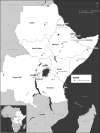Laboratory capacity for diagnosis of foot-and-mouth disease in Eastern Africa: implications for the progressive control pathway
- PMID: 23347795
- PMCID: PMC3562503
- DOI: 10.1186/1746-6148-9-19
Laboratory capacity for diagnosis of foot-and-mouth disease in Eastern Africa: implications for the progressive control pathway
Abstract
Background: Accurate diagnosis is pertinent to any disease control programme. If Eastern Africa is to work towards control of foot-and-mouth disease (FMD) using the Progressive Control Pathway for FMD (PCP-FMD) as a tool, then the capacity of national reference laboratories (NRLs) mandated to diagnose FMD should match this task. This study assessed the laboratory capacity of 14 NRLs of the Eastern Africa Region Laboratory Network member countries using a semi-structured questionnaire and retrospective data from the World Reference Laboratory for FMD annual reports and Genbank® through National Centre for Biotechnology Information for the period 2006-2010.
Results: The questionnaire response rate was 13/14 (93%). Twelve out of the 13 countries/regions had experienced at least one outbreak in the relevant five year period. Only two countries (Ethiopia and Kenya) had laboratories at biosecurity level 3 and only three (Ethiopia, Kenya and Sudan) had identified FMD virus serotypes for all reported outbreaks. Based on their own country/region assessment, 12/13 of these countries /regions were below stage 3 of the PCP-FMD. Quarantine (77%) and vaccination (54%) were the major FMD control strategies employed. The majority (12/13) of the NRLs used serological techniques to diagnose FMD, seven used antigen ELISA and three of these (25%) also used molecular techniques which were the tests most frequently requested from collaborating laboratories by the majority (69%) of the NRLs. Only 4/13 (31%) participated in proficiency testing for FMD. Four (31%) laboratories had no quality management systems (QMS) in place and where QMS existed it was still deficient, thus, none of the laboratories had achieved accreditation for FMD diagnosis.
Conclusions: This study indicates that FMD diagnostic capacity in Eastern Africa is still inadequate and largely depends on antigen and antibody ELISAs techniques undertaken by the NRLs. Hence, for the region to progress on the PCP-FMD, there is need to: implement regional control measures, improve the serological diagnostic test performance and laboratory capacity of the NRLs (including training of personnel as well as upgrading of equipment and methods, especially strengthening the molecular diagnostic capacity), and to establish a regional reference laboratory to enforce QMS and characterization of FMD virus containing samples.
Figures

References
-
- Kitching RP. Clinical variation in Foot and Mouth Disease: Cattle. Rev Sci Tech Off int Epiz. 2002;21:499–504. - PubMed
-
- Rweyemamu MM, Leforban Y. Foot-and-Mouth Disease and International Developments. Adv Virus Res. 1999;53:111. - PubMed
-
- Stanway G, Brown F, Christian P, Hovi T, Hyypia T, King AMQ, Knowles NJ, Lemon SM, Minor PD, Pallansch MA, In: Virus Taxonomy: classification and nomenclature of viruses Eighth Report of the International Committee on Taxonomy of Viruses. Fauquet CM, Mayo MA, Maniloff J, Desselberger U, Ball LA, editor. London: Elsevier/Academic Press; 2005. Family Picornaviridae; pp. 757–778.
-
- Vosloo W, Bastos AD, Sangare O, Hargreaves SK, Thomson GR. Review of the status and control of foot and mouth disease in sub-Saharan Africa. Rev Sci Tech. 2002;21:437–449. - PubMed
Publication types
MeSH terms
LinkOut - more resources
Full Text Sources
Other Literature Sources

